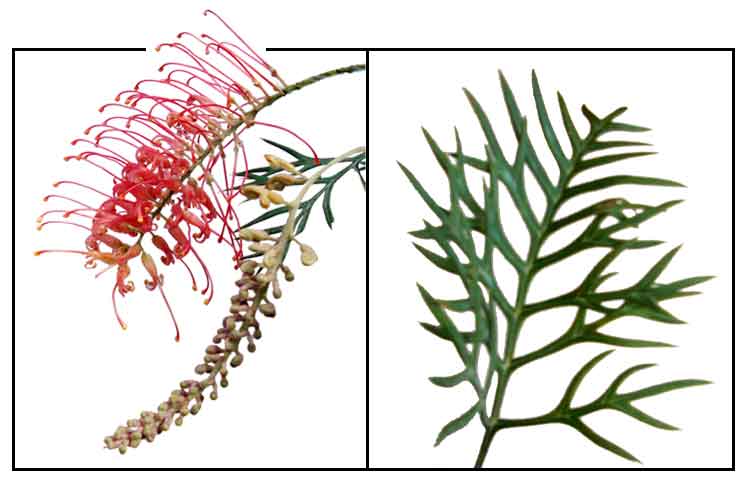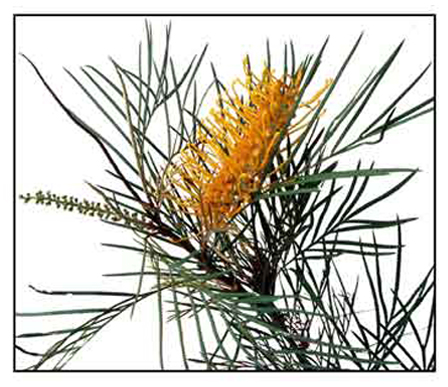Botany
Grevillea is a deciduous medium-sized tree that grows to 30
meters or taller. Bark is fissured, sometimes pustulate, dark grey to dark brown. Crown is conical and dense, with branches projecting upward. Leaves are alternate, fernlike, pinnate, 11 to 21 pairs of pinnae, 4 to 9 centimeters long, and dark green.
Leaflets are lanceolate, with entire or lobed margins. The flowers are
yellow to orange, numerous, paired, on long slender stalks 1 to 2 centimeters, with 4 narrow yellow or orange sepals 12 millimeters long. Fruits are podlike, broad, slightly flattened, 2 centimeters long, black, with 1 to 2 seeds, 10 to 13 millimeters long.
 Distribution Distribution
- Native to Australia.
- Exotic to China, Eritrea, Ethiopia, India, Indonesia, Jamaica, Kenya, Laos, Malawi, Malaysia, Mauritius, Nepal, Pakistan, Philippines, South Africa, Sri Lanka, Tanzania, Uganda, USA, Vietnam, Zambia and Zimbabwe. (10)
- Recently introduced to the Philippines.
- Grown as shade tree or ornamental for shape and foliage.
 Constituents Constituents
• Bioassay-guided fractionation of methanol extract of leaves isolated
six new 5-alkylresorcinals i.e., gravicycle (1), dehydrogravicycle (2), bisgravillol (3), dehydrobisgravillol (4), dehydrograviphane (5), and methyl-dehydrograviphane (6), along with eight known compounds. Graviphane (7) and methylgraviphane (8) were isolated in pure form. (1)
• Plant yields a small amount of gum resin.
• Leaves contain rutin.
• Intense yellow and green dyes from the leaves.
• Study yielded seven phenolic compounds from the methanolic extract of leaves – Grevirobstol A, B, C and Robustaside A, B, C and D.
• Study isolated three new compounds from the leaves: graviquinone (1), cis-3-hydroxy-5-pentadecylcyclohexanone (2), and methyl 5-ethoxy-2-hydroxycinnamate (3), together with 38 known compounds. (see study below) (12)
• 1-BuOH-soluble fraction of methanol extract of leaves yielded two 5-alkylresorcinol glucosides, named grevillosides G and H (1, 2), and grevilloside E methyl ester (3), along with one known megastigmane glucoside, staphylionoside D (4). (13)
• The 1-Bu-BuOH soluble fractions of a methanol extract of leaves isolated two 5-alkylresorcinol glucosides, named grevillosides G and H (1, 2), and grevilloside E methyl ester (3), along with one known megastigmane glucoside, staphylionoside D (4). (15)
Properties
• Flowers rich in vitamin C. Leaves and twigs reported to be high in aluminum. (12)
•
Studies have suggested scavenging activity, leishmanicidal, L-DOPA inhibitory properties.
Uses
Edibility
• Flowers are a
rich source of nectar which can be directly sucked from the flower, shaken into a bowl or washed out in a small amount of water.
• Aborigines in Australia reported to drink the nectar straight from the flowers.
Folkloric
- No known folkloric medicinal
use in the Philippines.
- In Kenya, natives of the Kakamega Forest use the plant to treat sore throats, earache, chest problems, flu and toothache.
- In North Garo Hills, Meghalaya, NE India, bark and leaves used for headaches and dizziness.
(14)
Others
• Dye: Yellow and green dye from the leaves; used for dyeing silk.
• Wood: Used for
joinery, cabinetry and paneling.
• Fuel: Wood makes a good charcoal. Used to fuel locomotives and river steamers, power boilers and small industries. Sapwood has calorific value of 4800 kcal/kg; the heartwood yields 4950 kcal/kg. (18)
• Gum or resin: Natural gum has potential as adhesive.
• Ornamental: Grown for its attractive foliage. Leaves used in flower arrangements.
•
Apiculture: Golden flowers are an attractant for bees, making it an important honey plant. (18)
• Poison: Flower buds, fruit and seeds
Caution !
• Poison: The flower buds, fruit and seeds are cyanogenic. Contact with leaves may cause contact dermatitis due to tridecylresorcinol, a chemical compound related to the allergen toxicodendron. (11)
• Contact
dermatitis: A report on a case of severe acute dermatitis
venenata due to exposure to sawdust of Grevillea robusta. (2) (3)
• Grevillol: Bracelets
made from the wood of Grevellia were shown to be a source of allergic
contact dermatitis. The responsible allergen was grevillol, a phenolic
with a long side chain resembling the sensitizing uroshiols from poison
ivy. source
• Eye Irritation: For all eye exposures, rinse the eye with water for 15 minutes. Seek medical assistance if irritation persists. Sap and sawdust may cause eye irritation. (18)
Studies
• Alkylresorcinols / Cytoxicity / Cancer Cell Lines / Leaves:
Study isolated
6 new 5-alkylresorcinols and 8 known compounds, all of which showed
marginal toxicity against MCF-7, NCI-H460 and SF-268 ki cell lines. (see constituents above) (1)
• Leishmanicidal: One of 75 Myanmar
timber extracts examined for leishmanicidal activity. source
• Cardiovascular Effects: Several his-resorcinols
were isolated from Grevellia robusta, the most potent, striatol, exhibiting
inhibitory activity on the Ca-ATPase system suggesting a potential for
cardiovascular activity. (5)
• Gum Adhesive: A natural gum from the plant has been studied and analysis showed that with suitable modifications, the gum from G robusta can be used as a wood adhesive. (9)
• Scavenging Activity / Cytotoxicity / Inhibition of L-DOPA / Leaves: Study isolated three new compounds from the leaves. Graviquinone, compound 1, showed strongest cytotoxicity against MCF-7, NCI-H460, and SF-268 cell lines. Methyl 2,3-dihydroxycinnamate (4), graviphane (13), and dehydrograviphane (14) showed very potent DPPH scavenging activity. Compounds 4 and bis-norstriatol (17) showed strong inhibition of L-DOPA. (see constituents above) (12)
• Gum Adhesive / Leaves: Study evaluated a crude methanolic extract of leaf of Grevillea robusta and various soluble partitionates for cytotoxic, thrombolytic, membrane stabilizing and antimicrobial activities. The crude ME showed highest cytotoxic activity in brine shrimp lethality bioassay with LC50 values of 1.50±0.45 µg/ml. Extractives showed 69.95±0.11% clot lysis. A chloroform soluble fraction inhibited hemolysis of RBC induced by heat and hypotonic solution. A chloroform partitionate showed highest zone of inhibition against Salmonella typhi. (16)
• Cytotoxic / Thrombolytic / Membrane Stabilizing / Antimicrobial / Leaves: Study evaluated various extracts of crude methanol leaf extract of Grevillea robusta and its partitionates for cytotoxic, thrombolytic, membrane stabilizing and antimicrobial activities. In brine shrimp lethality assay, a crude methanolic extract showed highest cytotoxic activity with LC50 of 1.50 ± 0.45 µg/ml compared to 0.45 µg/mL for vincristine sulphate. A carbon tetrachloride soluble fraction showed 69.95 ± 0.11% clot lysis compared to 70.77% by standard streptokinase. A chloroform soluble fraction inhibited 40.31 ± 0.59% and 62.93 ± 0.73% of hemolysis of RBC induced by heat and hypotonic solution. Antimicrobial activity showed zones of inhibition ranging from 7.0 to 17.0 mm in diameter, with a chloroform soluble partitionale showing highest zone of inhibition against Salmonella typhi. (17)
• Effect of Heat Treatment on Wood: Study evaluated the heat treatment of G. robusta under inert conditions to improve its decay resistance by malt agar block tests after three months of exposure to several rotting fungi. Results showed durability against fungi and termites was greatly improved after treatment. There was good correlation between decay resistance and mass loss due to thermal treatment. (19)
Availability
- Recently for introduced.
- Ornamental cultivation.
- Seeds in the cybermarket.
|


 Distribution
Distribution Constituents
Constituents


